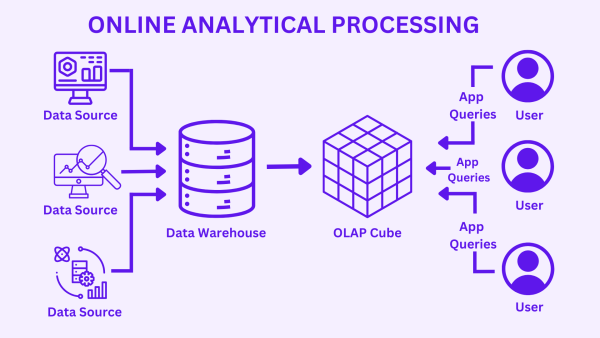Airport Operations and Data Storage Systems
Efficient data handling is critical for safety, operational efficiency, and enhancing the passenger experience in airport operations. With massive amounts of data generated every day, understanding the different types of data storage systems—and their practical applications—is essential. This article explores the roles of databases, data warehouses, data marts, and data lakes in optimizing airport operations.
Types of Data Storage Systems in Airports
1. Database: Application-Specific Data Management
Scope:
A database is an application-specific storage system designed for managing structured data. It is the backbone of Online Transaction Processing (OLTP) systems, critical for real-time operations.
Structure:
Databases operate on a predefined schema, handling structured data efficiently. This ensures consistency and reliability in formats such as passenger records or flight schedules.
Use Cases in Airport Operations:
- Passenger Check-In Systems: Manage passenger details, boarding passes, and seat assignments.
- Baggage Handling Systems: Track baggage from check-in to unloading at the destination.
- Security Screening Systems: Store data from security checks, ensuring compliance with regulatory standards.
By enabling real-time data access and transactional consistency, databases support seamless daily operations.
2. Data Warehouse: Organization-Wide Historical Data
Scope:
A data warehouse aggregates structured and semi-structured data from multiple sources across an organization. It is primarily used for Online Analytical Processing (OLAP), providing valuable insights for historical and business intelligence analysis.

for further reading – link
Structure:
Data warehouses use a schema-on-write approach. Data is formatted and structured before storage, enabling efficient querying and analysis. They can handle semi-structured data, such as JSON files or XML, commonly found in operational logs and API data exchanges.
Use Cases in Airport Operations:
- Flight Performance Analysis: Review historical data on flight delays and cancellations.
- Passenger Flow Optimization: Analyze passenger movement to reduce wait times and optimize staffing.
- Resource Allocation: Use historical trends to predict peak times and allocate resources such as gates and security staff efficiently.
Data warehouses offer a centralized view of airport operations, empowering authorities to make data-driven decisions.
3. Data Mart: Department-Specific Data Insights
Scope:
A data mart is a subset of a data warehouse tailored to a specific department or business function. This focused approach streamlines data analysis for individual teams.
Structure:
Data marts use a schema-on-write structure, similar to data warehouses, but they are also capable of storing semi-structured data. This allows departments to work with diverse datasets relevant to their operations.
Use Cases in Airport Operations:
- Baggage Operations: Track baggage movement, lost items, and system performance.
- Customer Service: Analyze passenger feedback, complaint resolution times, and service quality metrics.
- Security Operations: Monitor incidents, response times, and regulatory compliance.
Data marts ensure departments have access to relevant data, including semi-structured information, without being overwhelmed by irrelevant details.
4. Data Lake: Handling Diverse Data Types
Scope:
A data lake stores large volumes of raw data, accommodating structured, semi-structured, and unstructured data. It is highly flexible and ideal for big data and exploratory analysis.
Structure:
Data lakes use a schema-on-read approach, meaning the data structure is applied only when the data is queried. This makes them suitable for handling diverse and evolving data types.
Use Cases in Airport Operations:
- IoT Data: Store sensor data, including temperature, humidity, and noise levels.
- Video Surveillance: Archive unstructured video footage from security cameras.
- Passenger Behavior Analytics: Analyze data from social media, customer feedback, and airport Wi-Fi to enhance the passenger experience.
Data lakes support advanced analytics, enabling airports to uncover insights from unconventional data sources.
Comparison of Data Storage Systems
| Aspect | Database | Data Warehouse | Data Mart | Data Lake |
|---|---|---|---|---|
| Scope | Application-specific | Organization-wide | Department-specific | Organization-wide, any type of data |
| Data Type | Structured | Structured, Semi-structured | Structured, Semi-structured | Structured, Semi-structured, Unstructured |
| Structure | Predefined schema | Schema on write | Schema on write | Schema on read |
| Use Case | Operational (OLTP) | Business intelligence (OLAP) | Functional analysis | Big data, exploratory analysis |
Key Considerations for Implementing Data Storage Solutions
When choosing the right data storage solution for airport operations, consider the following factors:
- Data Volume: Databases handle daily operations efficiently, while data lakes are ideal for massive raw data volumes.
- Data Variety: Airports often need to manage structured data from operational systems alongside unstructured data from IoT devices and video surveillance. Combining data warehouses and lakes is a common solution.
- Data Velocity: Real-time data access is critical for managing flight schedules, passenger flows, and security checks. Databases excel in real-time scenarios, while warehouses and lakes handle analytical data.
- Compliance and Security: Ensure all storage systems adhere to data protection laws such as GDPR or CCPA, with robust encryption and access controls.
Conclusion
Effective data management is essential for improving safety, operational efficiency, and passenger satisfaction in airport operations. By understanding and leveraging databases, data warehouses, data marts, and data lakes, airports can:
- Optimize daily operations.
- Make informed, data-driven decisions.
- Enhance passenger experiences.
- Ensure compliance with regulatory standards.
Investing in the right data storage solutions allows airports to harness the full potential of their data, creating smarter, more connected operations.
Suggested article – Understanding Stakeholders in an Airline Company


